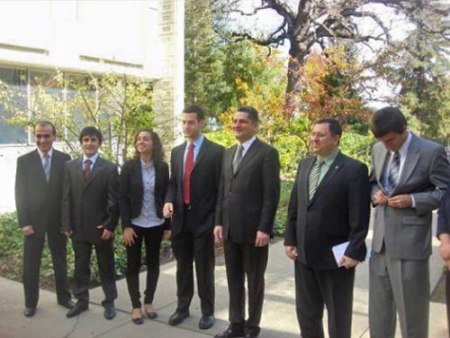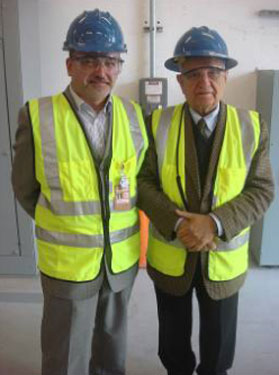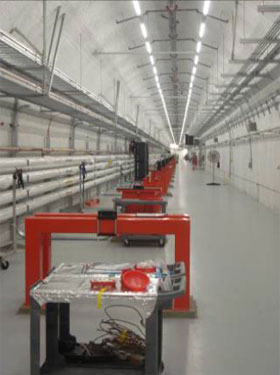
| 2009-11-15 04:55:45 |
|
Report on participation in the Armenian high tech industry (ArmTech) Congress’ 09, Silicon Valley and meetings in SLAC, November 4-13, 2009
1. On November 4 I was among the delegation accompanying the PM of Armenia Tigran Sargsyan in his visits to Stanford Linear Accelerator Center (SLAC) and Berkley University. At SLAC Mr. Sargsyan met with Director of SLAC – Dr. Persis Drell, Associate Lab Director - Dr. Dale Knutson, Director of Accelerator Research department Dr. Tor Raubenheimer, and the Armenian students of the Stanford university. PM was introduced to the history of SLAC, ongoing research and development of the new accelerators for powerful light sources and for medicine. The status of national lab (SLAC present status) was also explained and discussed. During the meetings with the Armenian students and the representative of the Silicon valley Armenian diaspora in Berkeley, PM talked over the RA politics to support the education of Armenian students in the country and abroad in world-best universities. The new organized National Competitiveness council and Luis foundation will coordinate projects in tourism, education and health care. The Yerevan Physics institute, to be turned into National lab, will actively participate in nuclear medicine establishing in Armenia.
2. On November 6 and 7 I participated in the plenary and section sessions of the ArmTech congress. Plenary sections were very interesting; the presidents and CEO of big companies based in the Silicon Valley presented a broad picture of the high tech industry development and the possibilities of Armenia to take part in it. Unfortunately, ArmTech section sessions were not much populated and business contacts were very rare. There was an impression, that Armenian representatives, despite very interesting projects, were not sufficiently prepared for business contacts.They did not elaborate business schemes to involve private capital (applying for loans, selling a part of business, etc...) and they were not ready to share the business with private people to recieve investments. The estimates of the expected profit and of the product price were also a bit arbitrary. In my plenary presentation “Applied Cosmic Ray Physics:Science-Technology-Innovation" I tried to demonstrate the connections between fundamental science and innovation illustrating the Space Weather research in Cosmic Ray Division of Yerevan Physics Institute. It is a new emerging scientific field, as well as a new emerging commercial service.Fundamental science in this case is directly creating a new innovative technology. In the Space Weather research we have performed fundamental research, technological know-how and elaborated business schemes in one and the same project, that is very challenging. However, this has resulted from a big demand in new innovative technologies and products necessary for overcoming of the economical crisis. The ArmTech congress aimed at developing knowledge based economy in Armenia via business/academia cooperation invoking the intellectual capital and entrepreneurship experience from Diaspora. This goal can be achieved through the improvement of education at all levels; building strong Internet presence; focusing on programs to end up on the products or services; and by reforming and creating transparent government agencies.

Figure 1. Armenia’s PM Tigran Sargsyan and Economy Minister Nerses Yeritsyan with Stanford students, SLAC, Stanford, 5 November, 2009
Accelerator Division at SLAC:
3. Meeting with Dr. Sami Tantawi, head of the group of the Advanced Microwave Technology Research (ATR), 10 November, 2009. Different applications of the accelerator technologies were discussed: The total volume of the accelerator production industry in the USA reached 3.5 bln in 2008; most popular are small 7-8 MeV electron accelerators for cancer treatment. 3,000 of such accelerators have already been installed in the USA. 60% of the world market of these accelerators is occupied by the Silicon Valleybased "Varian" firm, producing one accelerator per day. Another promising application is the welfares cutting technology - proton beam by charging the chip can cut on atomic length scale - economy up to 70% of silicon; very important for the 60 nm technology. In 2008, 30% of food in the USA was exposed to radiation sources (sterilized) to survive at least 10 time more. All tiresin the USA also passed radioactive treatment to serve longer.
4. At the meeting on November 11 with SLAC Director of Accelerator Research department Dr. Tor Raubenheimer participated also senior ISTC manager Dr. Karen Bunyatov , academician Robert Avagyan, YerPhI director A.Chilingarian. T.Raubenheimer informed about the possible joint institutions projects connected with applications of the accelerator technologies in medical diagnostics and treatment. A mutual interest was expressed in high current and compact electron linear accelerators (LINACs) in the energy range of 30-40 MeV for medicalisotopes production. New compact LINACs are under design now . Robert Avakian informed about the project of generating the Tc-99m for SPECT diagnostic on electron linear accelerator which is now under test at YerPhI. New possibilities for Tc-99m separation now are also under investigation in his group. Karen Buniatov expressed interest of ISTC in theYerPhI sustainability plan which major part is the development of the accelerator applied technologies. Both sides expressed interest in collaboration and decided to prepare a memorandum of understanding (MOU). The same day Armenian delegation visited new SLAC facility.

Figure 2. Karen Bunyatov and Robert Avagyan are going to visit the LCLS.

Figure 3. The 12 GeV electron accelerator of the LCLS.
The Linac Coherent Light Source (LCLS) provides the world's brightest, shortest pulses of laser X-rays for various fundamental and applied studies.It will give scientists an unprecedented tool for studying and understanding the arrangement of atoms in semiconductors, ceramics, polymers, catalysts,plastics, and biological molecules, with wide-ranging impact on advanced research in other fields.
The LCLS X-ray beam is brighter than any other human-made source of short-pulse, hard X-rays. Initial tests produced laser light with a wavelength of 1.5 Angstroms, or 0.15 nanometers—the shortest-wavelength, highest-energy X-rays ever created by any laser. To generate that light, thet eam had to align the electron beam with extreme precision of 5 micrometers per 5 meters.
Unlike conventional lasers, which use mirrored cavities to amplify light, the LCLS is a free-electron laser, creating light using free-flying electrons in a vacuum. The LCLS uses the final third of SLAC's two-mile linear accelerator to drive electrons to high energy and through an array of "undulator" magnets (33 Wiglers, only 12 used) that steer the electrons rapidly back and forth, generating a brilliant beam of coherent X-rays.
5. On November 10 I held a seminar for the Stanford/KAvli particle astrophysics group on the recent discovery of powerful electron accelerator operating in lower atmosphere,named “Thunderstorm Correlated Fluxes of electrons, Gammas and Neutrons Observed at Mountain Altitudes”. The same seminar was held also for the solar physics group of the Lockheed Martin's Advanced Technology Center in Palo Alto.
